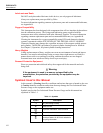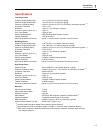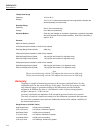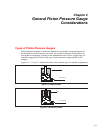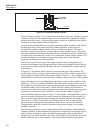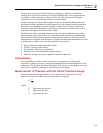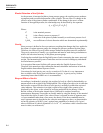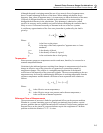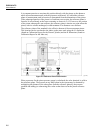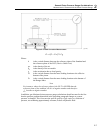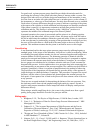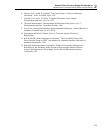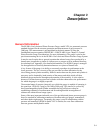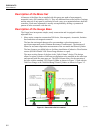
General Piston Pressure Gauge Considerations
Measurement of Pressure with the Piston Pressure Gauge 2
2-5
Although the trend is swinging toward the use of true mass in favor of apparent mass,
there is a small advantage in the use of the latter. When making calculations for air
buoyancy from values of apparent mass, it is unnecessary to know the density of the mass.
If objects of different densities are included in the calculation, it is not necessary to
distinguish the difference in the calculations. This advantage is obtained at a small
sacrifice in accuracy and is probably not justified when considering the confusion that is
likely to occur if it becomes necessary to alternate in the use of the two systems.
A satisfactory approximation of the force on a piston that is produced by the load is
given by:
g
p
p
MF
BRASS
AIR
A
⎟
⎟
⎠
⎞
⎜
⎜
⎝
⎛
−= 1
Where:
F is the force on the piston
A
M
is the mass of the load, reported as "apparent mass vs. brass
standards"
AIR
p
Is the density of the air
BRASS
p Is the density of brass (8.4 g/cm³)
g
is the acceleration due to local gravity
Temperature
Piston pressure gauges are temperature sensitive and must, therefore, be corrected to a
common temperature datum.
Variations in the indicated pressure resulting from changes in temperature arise from the
change in effective area of the piston due to expansion or contractions caused by
temperature changes. The solution is a straightforward application of the thermal
coefficients of the materials of the piston and cylinder. The area corresponding to the new
temperature may be found by substituting the difference in working temperature from the
reference temperature and the thermal coefficient of area expansion in the relation as
follows:
()
[]
rtcAA
rt
−+= 1
)(0)(0
Where:
)(0 t
A
is the effective area at temperature, t
)(0 r
A
is the effective area at zero pressure and reference temperature, r
c is the coefficient of thermal expansion
Reference Plane of Measurements
The measurement of pressure is linked to gravitational effects on the pressure medium.
Whether in a system containing a gas or a liquid, gravitational forces produce vertical
pressure gradients that are significant and must be evaluated. Fluid pressure gradients and
buoyant forces on the piston of a pressure balance require the assignment of a definite
position at which the relation
AFP /=
exists.




